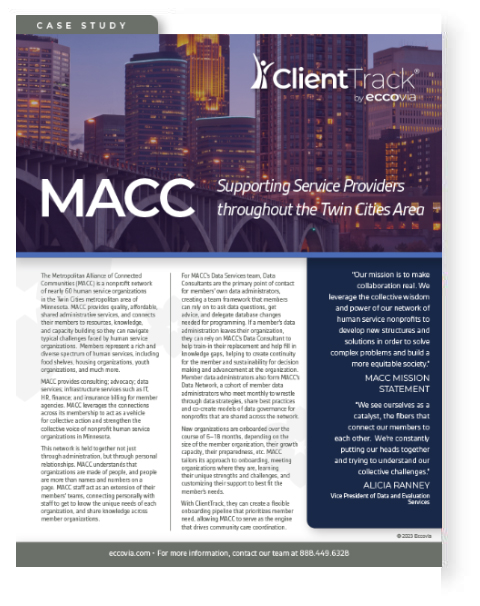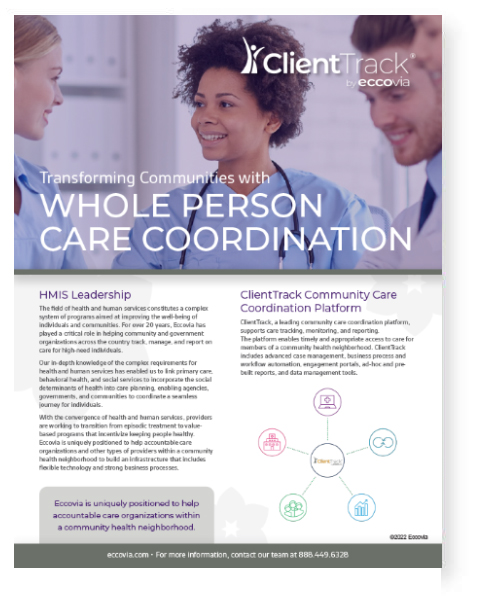Whole Person Care
- Easy and comprehensive data and service management
- Integration with third-party tools
- Faster and easier reporting
- Flexible and adaptable via robust designer toolset

Connecting Providers and Services
Bringing it All Together
Want to Learn More?
Use the button below to schedule a quick demo and learn how ClientTrack can help solve your data tracking needs.
Let Us Be Your Whole Person Care Partner
ClientTrack breaks down the information silos that so often impede case management and care coordination.
There are over 19 million veterans in the US, and each one deserves care from services that understand their unique needs. How well do you know the state of veteran care? Check out our three suggestions on how health and human service organizations can improve their veteran care.
Health and human service organizations are beginning to understand why working together is so important. By bridging the gaps of siloed care through whole person care, these organizations can successfully accomplish the "triple aim": improving the patient experience, improving health outcomes, and reducing the cost of healthcare.
Is your organization properly addressing minority mental health? Understanding the unique needs of minorities is imperative to lasting community change. By finding strength in communities, health and human service groups can better serve individuals and families.
As the summer months continue, experts warn of an uptick in domestic violence cases. Why does such violence increase during this warmer season? More importantly, what can your social service organization do to help?
Whole person care is gradually becoming more prevalent in the realm of health and human service organizations. But what exactly does it mean? Check out the definition and importance of whole person care, as well as how your organization can begin implementing it today.
Did you know May is both Mental Health Awareness AND Teen Self-Esteem Month? Pivot Adventure, a non-profit in Utah, utilizes recreational therapy to provide affordable mental health courses for teenagers. Their unique approach is critical to the effectiveness of these social services.
Is your organization addressing mental health concerns? If you work in the health and human services industry, then your program could benefit from focusing on mental health. Consider these three simple steps below to begin incorporating mental and behavioral health into your social services.
Earlier this year, we discussed what refugee resettlement programs can expect in 2021. Many of these expectations have changed—despite big promises from the current administration, only 2,050 refugees have been admitted to the US during the 2020-21 fiscal year (Sep—Aug). What are the problems facing refugees amidst these changes?
Americans experience some of the highest rates of stress in the world. Those in lower socio-economic brackets report even higher levels, and this can negatively impact their overall health. A whole person care approach can help health and human service organizations better address stress.
This year’s theme for World Health Day is “Building a Fairer, Healthier World”. Key to accomplishing this goal is understanding—and addressing—social determinants of health. As more healthcare providers take a holistic approach to health, more individuals and communities will receive the care they need.
What is the best treatment for cancer? While there may not be one simple answer, experts agree on the importance of a whole person care approach. Through social determinants of health, programs and organizations can better help cancer patients by providing the care that they need.
As the Biden Administration implements a historic limit of 125,000 refugees into the US, resettlement programs can expect new changes with their budget but should prepare for a more gradual shift in execution.
While the new year is usually the best time to look for a new job, unprecedented spikes in unemployment due to the COVID-19 pandemic may prove otherwise.
December 10th marks seventy-two years since the creation of the Universal Declaration of Human Rights. By utilizing principles of human rights, social programs can better inform and improve social determinants of health (SDoH). […]
With another World AIDS Day behind us, programs within the United States and across the globe, are still working tirelessly to stop the spread of HIV/AIDS. As one of the biggest health crises […]
Get Started
By Phone
Contact us today to learn how Eccovia can help you achieve improved outcomes for the people your organization serves.

















